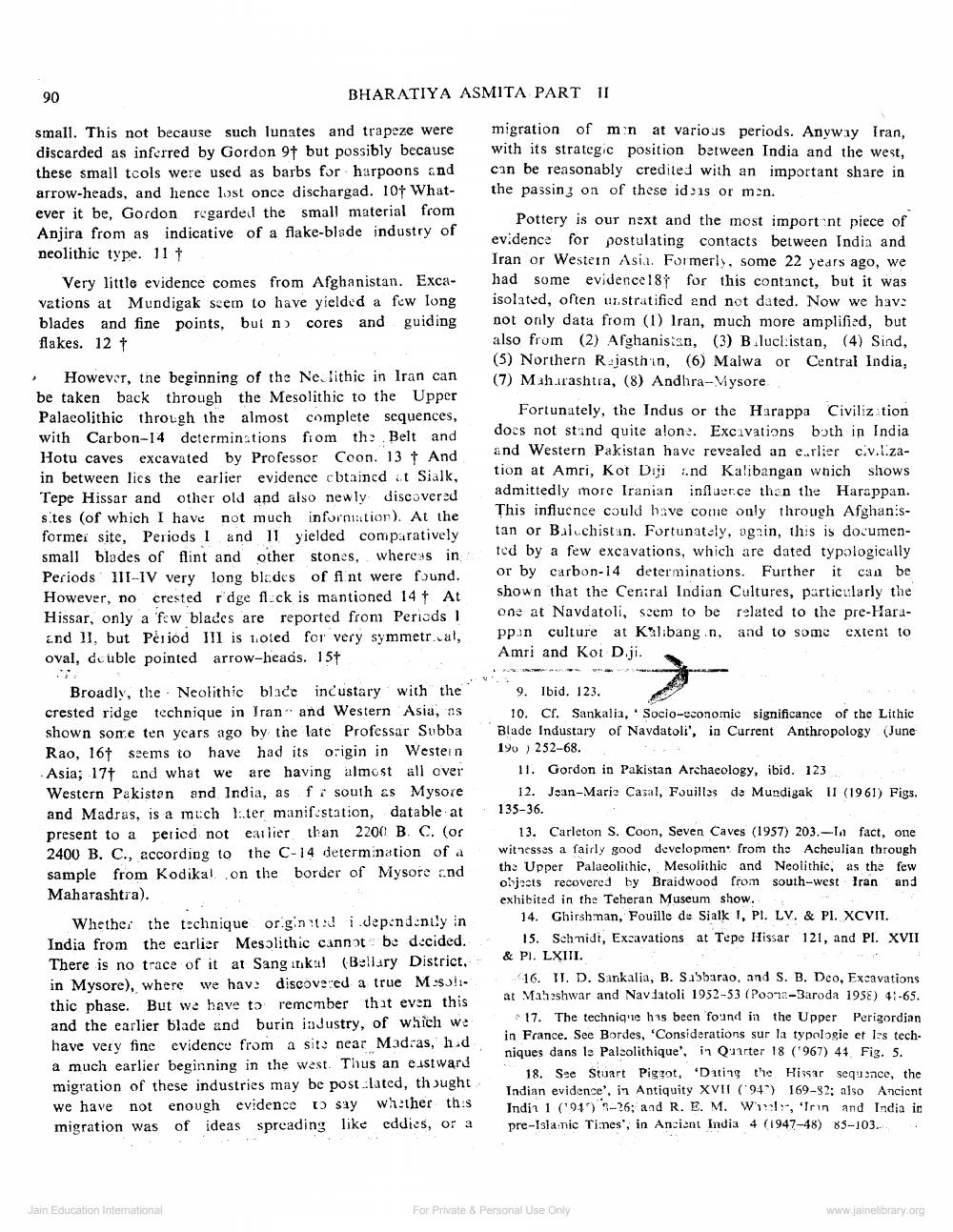________________
90
small. This not because such lunates and trapeze were discarded as inferred by Gordon 9† but possibly because these small tcols were used as barbs for harpoons and arrow-heads, and hence lost once dischargad. 10† Whatever it be, Gordon regarded the small material from Anjira from as indicative of a flake-blade industry of neolithic type. 11 †
BHARATIYA ASMITA PART II
Very little evidence comes from Afghanistan. Excavations at Mundigak seem to have yielded a few long blades and fine points, but no cores and guiding flakes. 12 †
However, the beginning of the Ne. lithic in Iran can be taken back through the Mesolithic to the Upper Palaeolithic through the almost complete sequences, with Carbon-14 determinations from the Belt and Hotu caves excavated by Professor Coon. 13 † And in between lies the earlier evidence cbtained at Sialk, Tepe Hissar and other old and also newly discovered sites (of which I have not much information). At the forme site, Periods I and II yielded comparatively small blades of flint and other stones, whereas in Periods III-IV very long blades of fint were found. However, no crested ridge flick is mantioned 14† At Hissar, only a few blades are reported from Periods 1 and II, but Period III is noted for very symmetr.cal, oval, double pointed arrow-heads. 15+
Broadly, the Neolithic blade incustary with the crested ridge technique in Iran and Western Asia, as shown some ten years ago by the late Professar Subba Rao, 16† seems to have had its origin in Western Asia; 17 and what we are having almost all over Western Pakistan and India, as fr south as Mysore and Madras, is a much later manifestation, datable at present to a period not earlier than 2200 B. C. (or 2400 B. C., according to the C-14 determination of a sample from Kodikal on the border of Mysore and Maharashtra).
Whether the technique originated i.dependently in India from the earlier Mesolithic cannot be decided. There is no trace of it at Sang inkal (Bellary District. in Mysore), where we have discovered a true Mesol thic phase. But we have to remember that even this and the earlier blade and burin industry, of which we have very fine evidence from a site near Madras, had a much earlier beginning in the west. Thus an eastward migration of these industries may be post lated, thought we have not enough evidence to say migration was of ideas spreading like
Jain Education International
whether this eddies, or a
migration of men at various periods. Anyway Iran, with its strategic position between India and the west, can be reasonably credited with an important share in the passing on of these ideas or men.
Pottery is our next and the most important piece of evidence for postulating contacts between India and Iran or Western Asia. Formerly, some 22 years ago, we had some evidence 18† for this contanct, but it was isolated, often unstratified and not dated. Now we hav not only data from (1) Iran, much more amplified, but also from (2) Afghanistan, (3) Blucl:istan, (4) Sind, (5) Northern Rajasthan, (6) Malwa or Central India, (7) Maharashtra, (8) Andhra-Mysore
Fortunately, the Indus or the Harappa Civilization does not stand quite alone. Excavations both in India and Western Pakistan have revealed an earlier civilization at Amri, Kot Diji and Kalibangan which shows admittedly more Iranian influence than the Harappan. This influence could have come only through Afghanistan or Balochistan. Fortunately, again, this is documented by a few excavations, which are dated typologically or by carbon-14 determinations. Further it can be shown that the Central Indian Cultures, particularly the one at Navdatoli, seem to be related to the pre-Harappan culture at Kalibang.n, and to some extent to Amri and Kot Diji.
9. Ibid. 123.
10. Cf. Sankalia, Socio-economic significance of the Lithic Blade Industary of Navdatoli', in Current Anthropology (June 190) 252-68.
11. Gordon in Pakistan Archaeology, ibid. 123
12. Jean-Marie Casal, Fouilles de Mundigak II (1961) Figs. 135-36.
13. Carleton S. Coon, Seven Caves (1957) 203.-In fact, one witnesses a fairly good development from the Acheulian through the Upper Palaeolithic, Mesolithic and Neolithic, as the few objects recovered by Braidwood from south-west Iran and exhibited in the Teheran Museum show.
14. Ghirshman, Fouille de Sialk I, Pl. LV. & Pl. XCVII.
15. Schmidt, Excavations at Tepe Hissar 121, and PI. XVII & Pl. LXIII.
16. II. D. Sankalia, B. Sabbarao, and S. B. Deo, Excavations at Maheshwar and Navdatoli 1952-53 (Poona-Baroda 1958) 41-65.
17. The technique has been found in the Upper Perigordian in France. See Bordes, 'Considerations sur la typologie et les techniques dans le Paleolithique', in Quarter 18 (967) 44 Fig. 5.
18. See Stuart Piggot, 'Dating the Hissar sequence, the Indian evidence', in Antiquity XVII (94) 169-82; also Ancient India 1 (194) 3-26; and R. E. M. Wel, 'Iran and India in pre-Islamic Times', in Ancient India 4 (1947-48) 85-103.
For Private & Personal Use Only
www.jainelibrary.org




